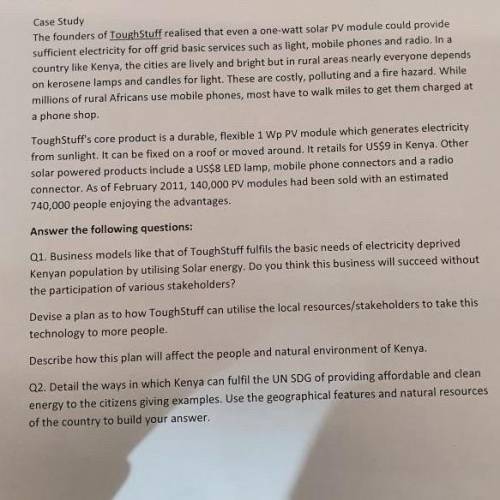
Business, 04.11.2021 14:00 cheergirl21
Case Study
The founders of ToughStuff realised that even a one-watt solar PV module could provide
sufficient electricity for off grid basic services such as light, mobile phones and radio. In a
country like Kenya, the cities are lively and bright but in rural areas nearly everyone depends
on kerosene lamps and candles for light. These are costly, polluting and a fire hazard. While
millions of rural Africans use mobile phones, most have to walk miles to get them charged at
a phone shop
ToughStuff's core product is a durable, flexible 1 Wp PV module which generates electricity
from sunlight. It can be fixed on a roof or moved around. It retails for US$9 in Kenya. Other
solar powered products include a US$8 LED lamp, mobile phone connectors and a radio
connector. As of February 2011, 140,000 PV modules had been sold with an estimated
740,000 people enjoying the advantages.
Answer the following questions:
Q1. Business models like that of ToughStuff fulfils the basic needs of electricity deprived
Kenyan population by utilising Solar energy. Do you think this business will succeed without
the participation of various stakeholders?
Devise a plan as to how ToughStuff can utilise the local resources/stakeholders to take this
technology to more people.
Describe how this plan will affect the people and natural environment of Kenya.
Q2. Detail the ways in which Kenya can fulfil the UN SDG of providing affordable and clean
energy to the citizens giving examples. Use the geographical features and natural resources
of the country to build your answer.


Answers: 3


Another question on Business

Business, 22.06.2019 07:20
Richardson hired j.c. flood company, a plumbing contractor, to correct a stoppage in the sewer line of her house. the plumbing company's 'snake' device, used to clear the line leading to the main sewer, became caught in the underground line. to release it, the company excavated a portion of the sewer line in richardson's backyard. in the process, the company discovered numerous leaks in a rusty, defective water pipe that ran parallel with the sewer line. to meet public regulations, the water pipe, of a type no longer approved for such service, had to be replaced either then or later, when the yard would have to be excavated again. the plumbing company proceeded to repair the water pipe. though richardson inspected the company's work daily and did not express any objection to the extra work involved in replacing the water pipe, she refused to pay any part of the total bill after the company completed the entire operation. j.c. flood company then sued richardson for the costs of labor and material it had furnished. (c) for what, if anything, should richardson be liable? explain."
Answers: 1

Business, 22.06.2019 12:30
Acorporation a. can use different depreciation methods for tax and financial reporting purposes b. must use the straight - line depreciation method for tax purposes and double declining depreciation method financial reporting purposes c. must use different depreciation method for tax purposes, but strictly mandated depreciation methods for financial reporting purposes d. can use straight- line depreciation method for tax purposes and macrs depreciation method financial reporting purposes
Answers: 2

Business, 22.06.2019 17:40
Adamson company manufactures four lines of garden tools. as a result of an activity analysis, the accounting department has identified eight activity cost pools. each of the product lines is produced in large batches, with the whole plant devoted to one product at a time. classify each of the following activities or costs as either unit-level, batch-level, product-level, or facility-level. activities (a) machining parts. (b) product design. (c) plant maintenance. (d) machine setup. (e) assembling parts. (f) purchasing raw materials. (g) property taxes. (h) painting.
Answers: 2

Business, 22.06.2019 18:00
1. what is the amount of interest earned after two years on a $100 deposit paying 4 percent simple interest annually? $8.00 $4.08 $8.16 $4.00 2. what is the amount of compound interest earned after three years on a $100 deposit paying 8 percent interest annually? $24.00 $8.00 $16.64 $25.97 3. a business just took out a loan for $100,000 at 10% interest. if the business pays the loan off in three months, how much did the business pay in interest? $2,500.00 $10.00 $250.00 $10,000.00 4. what is the annual percentage yield (apy) for a deposit paying 5 percent interest with monthly compounding? 5.00% 5.12% 79.59% 0.42%
Answers: 1
You know the right answer?
Case Study
The founders of ToughStuff realised that even a one-watt solar PV module could provide<...
Questions


Mathematics, 23.01.2021 06:10

Mathematics, 23.01.2021 06:10

History, 23.01.2021 06:10


Social Studies, 23.01.2021 06:10


Mathematics, 23.01.2021 06:10

English, 23.01.2021 06:10

Mathematics, 23.01.2021 06:10

Mathematics, 23.01.2021 06:10


Mathematics, 23.01.2021 06:10

Mathematics, 23.01.2021 06:10


History, 23.01.2021 06:10


Business, 23.01.2021 06:10

Biology, 23.01.2021 06:10



